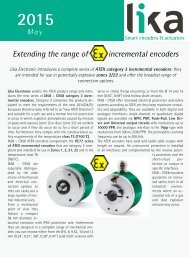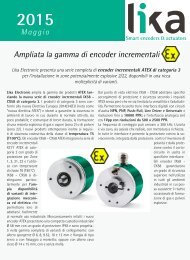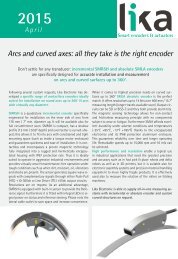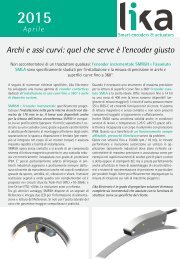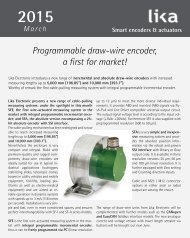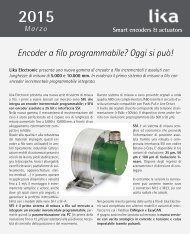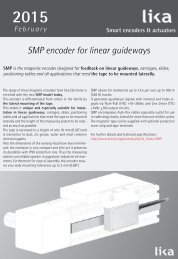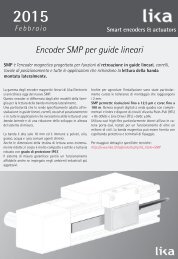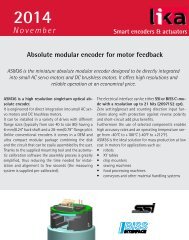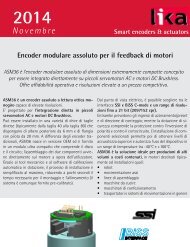LINEPULS & LINECOD catalogue 2016 in English
Lika Electronic incremental and absolute linear encoders catalogue 2016 in English Our new linear encoders catalogue is out now, and features many innovative new products and up-to-date information. The catalogue is expressly designed to set out the comprehensive range of incremental & absolute linear encoders from Lika Electronic. Check it out, it is completely renewed! Make sure you don’t miss out on a copy, download the pdf file from our web site or request your hard copy now! We have also got an interactive digital version in the works that shall be released soon!
Lika Electronic incremental and absolute linear encoders catalogue 2016 in English
Our new linear encoders catalogue is out now, and features many innovative new products and up-to-date information. The catalogue is expressly designed to set out the comprehensive range of incremental & absolute linear encoders from Lika Electronic. Check it out, it is completely renewed!
Make sure you don’t miss out on a copy, download the pdf file from our web site or request your hard copy now!
We have also got an interactive digital version in the works that shall be released soon!
You also want an ePaper? Increase the reach of your titles
YUMPU automatically turns print PDFs into web optimized ePapers that Google loves.
<strong>LINEPULS</strong> • <strong>LINECOD</strong><br />
Technical <strong>in</strong>formation<br />
This is the maximum shock acceleration that the encoder is able to withstand without <strong>in</strong>duc<strong>in</strong>g<br />
a mechanical weakness and los<strong>in</strong>g the performances specified <strong>in</strong> the datasheet.<br />
Shock test is performed <strong>in</strong> compliance with the <strong>in</strong>ternational standard IEC EN 60068-2-27.<br />
Maximum values are permissible provid<strong>in</strong>g that the encoder is <strong>in</strong>stalled properly, follow<strong>in</strong>g<br />
carefully the <strong>in</strong>structions given <strong>in</strong> the technical documentation and comply<strong>in</strong>g with the<br />
mount<strong>in</strong>g tolerances <strong>in</strong>dicated by the manufacturer. Any mechanical shock and vibration<br />
exceed<strong>in</strong>g the stated values may cause damage to the encoder. Please further consider that<br />
an encoder is a delicate electronic equipment, for this reason it should not be subjected to<br />
excessive mechanical shock and vibration dur<strong>in</strong>g both <strong>in</strong>stallation and operation.<br />
Shock<br />
This is the maximum susta<strong>in</strong>ed vibration that the encoder is able to withstand without <strong>in</strong>duc<strong>in</strong>g<br />
a mechanical weakness and los<strong>in</strong>g the performances specified <strong>in</strong> the datasheet. Vibration<br />
test is performed <strong>in</strong> compliance with the <strong>in</strong>ternational standard IEC EN 60068-2-6. Maximum<br />
values are permissible provid<strong>in</strong>g that the encoder is <strong>in</strong>stalled properly, follow<strong>in</strong>g carefully the<br />
<strong>in</strong>structions given <strong>in</strong> the technical documentation and comply<strong>in</strong>g with the mount<strong>in</strong>g tolerances<br />
<strong>in</strong>dicated by the manufacturer. Any mechanical shock and vibration exceed<strong>in</strong>g the stated<br />
values may cause damage to the encoder. Please further consider that an encoder is a delicate<br />
electronic equipment, for this reason it should not be subjected to excessive mechanical shock<br />
and vibration dur<strong>in</strong>g both <strong>in</strong>stallation and operation.<br />
Vibration<br />
Most of the outputs (refer to the section “Output circuits”) are protected aga<strong>in</strong>st shortcircuit.<br />
Short-circuit protection is <strong>in</strong>tended to keep the encoder electronics safe from accidental<br />
and temporary connection of one or more outputs either to 0Vdc, to +Vdc or to each<br />
other, provided that the power voltage is connected properly. If such a situation arises, no<br />
damage is caused to the circuitry, nevertheless it is compulsory to re-establish immediately<br />
the proper connection. Refer to the “Protection” <strong>in</strong>formation <strong>in</strong> the “Electrical Specifications”<br />
of the datasheet.<br />
Short-circuit protection<br />
Most of the Lika encoder versions (except some +5Vdc power supply versions; refer to the<br />
section “Output circuits”) implement the reverse polarity protection to prevent the <strong>in</strong>ternal<br />
electronics from be<strong>in</strong>g damaged <strong>in</strong> case the polarity is accidentally reversed on the connection.<br />
Refer to the “Protection” <strong>in</strong>formation <strong>in</strong> the “Electrical Specifications” of the datasheet.<br />
Reverse polarity protection<br />
IP -International Protection- code as def<strong>in</strong>ed <strong>in</strong> the <strong>in</strong>ternational standard IEC 60529 classifies<br />
the degrees of protection from solid objects and accidental contacts as well as from liquids<br />
provided by the enclosures of any electrical equipment. The protection rate is def<strong>in</strong>ed by the IP<br />
abbreviation followed by a two-digit number. The first digit <strong>in</strong>dicates the level of protection<br />
of the enclosure aga<strong>in</strong>st particles and solid objects; while the second digit <strong>in</strong>dicates the level<br />
of protection aga<strong>in</strong>st liquids. IP rat<strong>in</strong>gs are summarized <strong>in</strong> the table below.<br />
IP code<br />
IP first digit – Protection aga<strong>in</strong>st solid objects<br />
For <strong>in</strong>stance, if a product provides IP67-rated protection, this means that it is totally protected<br />
aga<strong>in</strong>st dust -first digit: 6- and protected aga<strong>in</strong>st immersion between a depth of 150 mm (6”)<br />
and 1000 mm (40”) -second digit: 7.<br />
IP second digit – Protection aga<strong>in</strong>st liquids<br />
0 No protection 0 No protection<br />
1 Protected aga<strong>in</strong>st solid objects 50 mm (2”) or greater 1 Protected aga<strong>in</strong>st vertically dripp<strong>in</strong>g water<br />
2 Protected aga<strong>in</strong>st solid objects 12 mm (0.47”) or greater 2 Protected aga<strong>in</strong>st vertically dripp<strong>in</strong>g water, when tilted 15 degrees<br />
3 Protected aga<strong>in</strong>st solid objects 2.5 mm (0.1”) or greater 3 Protected aga<strong>in</strong>st water spray<strong>in</strong>g at an angle up to 60 degrees<br />
4 Protected aga<strong>in</strong>st solid objects 1 mm (0.04”) or greater 4 Protected aga<strong>in</strong>st water splash<strong>in</strong>g from any direction<br />
5 Protected aga<strong>in</strong>st dust limited <strong>in</strong>gress 5 Protected aga<strong>in</strong>st jets of water from any directions<br />
6 Totally protected aga<strong>in</strong>st dust 6 Protected aga<strong>in</strong>st powerful jets of water from any directions<br />
Protected aga<strong>in</strong>st immersion between a depth of 150 mm (6”) and<br />
7<br />
1000 mm (40”)<br />
8 Protected aga<strong>in</strong>st cont<strong>in</strong>uous submersion<br />
18




